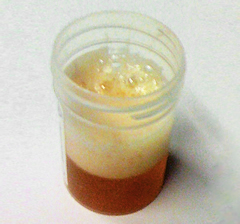A 54-yo man with mild HTN on no meds c/o of dysarthria, trouble with swallowing and moving his tongue. Neuro exam was normal except for left-side tongue deviation. Blood work excluded infection or immune disorders. An MRI was performed. What is it?

|
Carotid artery dissection
|
|
Complicated migraine
|
|
Acute cerebral vascular occlusion
|
|
Multiple sclerosis
|
|
Subarachnoid hemorrhage
|
(BMJ) - A 19-yo man with no PMHx had a chest tube placed for a large spontaneous pneumothorax. Symptoms initially improved, but soon he began coughing up frothy, clear, yellow, sputum and developed respiratory distress. X-ray was repeated. What is the diagnosis?


|
Atypical pneumonia
|
|
Lung abscess
|
|
Chest tube malfunction
|
|
Reexpansion pulmonary edema
|
|
Pulmonary hemorrhage
|
(BMJ) - A 74-yo man with no past medical Hx c/o pain and blisters on his right hand several hours after playing hockey. There was no trauma to his hands. He had no fever or other symptoms. What is the diagnosis?

|
Blistering distal dactylitis
|
|
Herpes zoster
|
|
Flexor tenosynovitis
|
|
Frostbite
|
|
Allergic reaction
|
(BMJ) - A 40-yo man c/o nasal blockage x 11 yrs, anosmia, and “something coming out of my nose.” Hx includes hay fever and aspirin intolerance. Exam revealed bilateral glistening fleshy structures in his nose, left worse than right. What is the diagnosis?

|
Deviated septum
|
|
Nasal foreign body
|
|
Rhabdomyosarcoma
|
|
Gross nasal polyps
|
|
Septal hematoma
|
A healthy 84-yo woman had 3 mo of double vision, droopy eyelids (worse on the right and in evening), and progressive bilateral arm weakness that was worse on exertion and better after rest. Cognition, reflexes, and sensation were normal. Diagnosis?


|
Botulism
|
|
Guillain-Barre syndrome
|
|
Posterior circulation stroke
|
|
Myasthenia gravis
|
|
Cavernous sinus thrombosis
|
(BMJ) - A healthy 22-yo woman presented with painful genital ulcers for 1 year, unresponsive to various treatments. Exam revealed labia majora and cervix lesions, aphthous-like oral lesions, and leg folliculitis. ESR was elevated. What is the diagnosis?


|
Herpes zoster
|
|
Disseminated gonorrhea
|
|
Systemic lupus erythematosus
|
|
Ulcerative colitis
|
|
Behcet disease
|
A 45-yo man presented with a 6-mo hx of diarrhea, abdominal pain, weight loss, and iron-deficiency anemia. Extensive work-up including stool studies, UGI, and limited colonoscopy was negative. Abdominal US and capsule endoscopy were performed. Diagnosis?



|
Whipworms (Trichuris trichiura)
|
|
Yersinia enterocolitica
|
|
Meckel diverticulum
|
|
Cecal malignancy
|
|
H pylori infection
|
A 6-yo boy presents with 1 mo of itchy 1- to 3-mm pearly, dome-shaped papules in a red, scaly, and slightly edematous area on the thighs. He is healthy with no history of atopy. What is it?

|
Impetigo
|
|
Lichen planus
|
|
Herpes zoster
|
|
Scabies
|
|
Molluscum-associated dermatitis
|
